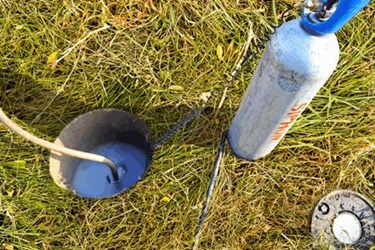Putting The Deep Freeze On Faulty Meter Box Valves

By Kipp Hanley, Prince William County Service Authority
This fall, the Prince William County Service Authority began using a device called a freeze kit, which temporarily freezes water service lines in order to replace angle valves in meter boxes.
Over time, angle valves — which allow water to travel through the meter and into a home — can fail or prove difficult to open or close. This issue is often discovered when a meter is shut on or off by the Service Authority or when a customer or realtor notices water coming from fixtures after service has been shut off.
The utility now has the technology to freeze the section of the service line extending from the main to the meter box in order to replace the faulty valve. This reduces the amount of time a customer may be without service.
Before acquiring the freeze kit, Service Authority field staff used a copper crimping tool to squeeze the copper tubing into a V-shape in order to stop the flow of water while making the necessary repairs. Once a faulty angle valve is replaced, the tool is used to reshape the copper.
While crimping is effective, it is more time consuming and labor-intensive than using the freeze kit. Using a crimping device entails digging a hole in order to work around the meter box. However, applying the freeze kit requires exposing only a few inches of the copper water line, said Collection and Distribution Assistant Team Leader Andrew Gardner.
“When you crimp and un-crimp a line, there is also a chance it may split or become misshapen, restricting water flow to the service,” said Gardner. “And you need a foot of space in all directions around the meter crock just to get the crimping tool on it.”
The Service Authority used the freeze kit for the first time in October 2016 at an abandoned home in Woodbridge, VA. The service line was frozen within 10 minutes, and the repair was complete in less than half an hour. The traditional crimping process can add 20 to 30 minutes to the process. Additionally, there was no need to refill an excavation with topsoil or put down seed and straw.
“It’s great to see our talented and motivated technicians apply innovation in a way that improves service to our customers,” said Operations and Maintenance Director Don Pannell.
